FINNS, SOVIETS END 1939–1940 WINTER WAR
Moscow, Union of Soviet Socialist Republics • March 13, 1940 (Finnish Time)
On this date in 1940, in the Soviet capital of Moscow, Finnish and Soviet delegates initialed the Treaty (or Peace) of Moscow. The terms of the agreement, dated March 12 (Moscow time), ended the so-called Winter War the Soviets had unleashed a little over 3 months before when half a million Red Army troops stormed into the Karelian Isthmus. Home to Finland’s fourth largest city, Viipuri (now the Russian city of Vyborg), the isthmus was the eastern-most part of Finland and practically bordered on Leningrad (today’s St. Petersburg), the Soviet Union’s second largest city and huge naval port with access to the Baltic Sea. The treaty ceded the 6,000‑sq‑mile/15,500‑sq‑km isthmus to the Soviet Union, and the entire Karelian population—about 422,000 people—was evacuated to other parts of Finland.
The surprise Soviet thrust into the Karelian Isthmus on November 30, 1939, was prompted by fears that Nazi Germany could possibly stage an attack on the Soviet Union through Finland. Normally such paranoia should have dissipated several months earlier in the wake of the long-antagonistic nations having concluded a 10‑year bilateral nonaggression pact, the Molotov-Ribbentrop Pact with its secret protocols for divvying Finland, the Baltic States, and Poland into twin spheres of influence. Nevertheless, Soviet representatives continued to badger their Finnish neighbors into swapping, ceding, or leasing land that would have pushed the Finnish Karelia border away from Leningrad and its approaches, but the Helsinki government either kept demurring or did diplomatic do-si-dos right up through November. When Soviet warriors did strike their neighbor of 3.7 million people, a day after severing diplomatic relations with Finland, they expected an easy victory because strength in manpower, armor, and aircraft was all on their side. Certainly, they thought, by next month’s end, when Soviet dictator Joseph Stalin’s 60th birthday rolled around on December 21, 1939, victory would be theirs.
Alas for Soviet war planners things began falling apart almost immediately. The League of Nations deemed the Soviet attack illegal, expelled the Soviet Union from its organization, and urged other nations—among them Great Britain, France, Italy, Sweden, and the U.S.—to aid Finland. Worse, Red Army khaki uniforms allowed Finnish sharpshooters to kill or wound tens if not hundreds of thousands of enemy soldiers against snow-white backgrounds. Soviet casualties—many attributed to frostbite and starvation—eventually numbered between 321,000 and 381,000, with some 5,500 taken prisoner. Noisy Soviet armor and long columns of men and artillery traveling over the area’s few roads in dense forests and swamps also made inviting targets to ambush and destroy. The Soviets lost between 1,200 and 3,500-plus tanks and maybe 1,000 aircraft during the course of the war. After 2 months of debilitating losses the Soviet military reorganized, flooded the theater with new tanks, artillery pieces, aircraft and men, and adopted more effective tactics that wore down the Finns.
Russo-Finnish hostilities ceased in March 1940 with the signing of the Moscow Peace Treaty. Finland ceded 11 percent of its territory, representing 30 percent of its economic assets, to the Soviet victors. Finland retained its sovereignty. Fifteen months later, in June 1941, Finland joined Nazi Germany in declaring war against the Soviet Union. The Winter War of 1939–1940 was thus followed by the Continuation War (June 25, 1941, to September 19, 1944) between the former co-belligerents. The second war translated into another Soviet tactical victory, this time accompanied by Finland paying $300 million in war reparations to the USSR. Because of Nazi Germany’s participation in the 1941–1944 period, a lack of consensus exists regarding the human and material losses in the Continuation War.
Finland’s Winter War, Late November 1939 to Mid-March 1940
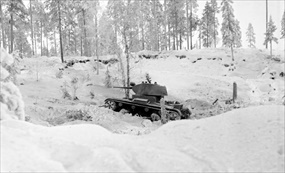 | 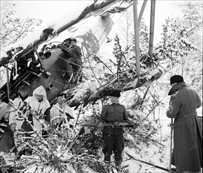 |
Left: A solitary Soviet T-26 Model 1937 tank rolls through a wintry Finnish forest. The underequipped Finns initially struggled to counter the Soviets’ armored columns. A cheap weapon Finns used against armored vehicles were Molotov cocktails, glass bottles filled with gasoline and tar that could be thrown at enemy targets. The Finns estimate that the number of lost Soviet tanks was 1,000–1,200 while their tank losses were 20–30.
![]()
Right: A Finnish patrol is seen here picking apart a downed Soviet airplane, perhaps after a Soviet sortie had gone bad. Much of the weaponry used by Finns during the Winter War was captured from the enemy. The Soviet Air Force lost around 1,000 aircraft. Just over half of the Soviet losses were combat casualties. Finns lost 62 aircraft.
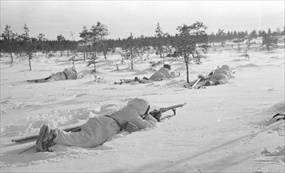 | 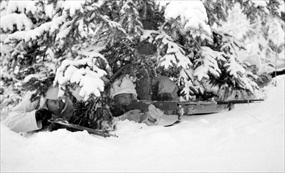 |
Left: Blending in with their surroundings these Finnish riflemen, outgunned and outnumbered by the enemy, used the advantages a Nordic winter provided with remarkable effect. Invading Red Army troops initially wore dark or khaki-colored uniforms, making them easy targets for sharpshooters. One Finnish sharpshooter, the diminutive (5 ft, 3 in/159.6 cm) Simo Häyhä, had 542 confirmed Soviet kills during the Winter War before he was seriously wounded by a Soviet marksman on March 6, 1940. His remarkable story is told in The White Sniper.
![]()
Right: Dressed in white camouflage, these Finnish defenders were almost impossible for the enemy to see in the snow-dusted forests through which they moved.
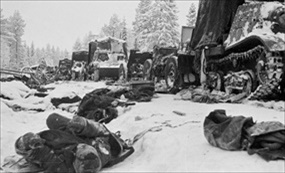 | 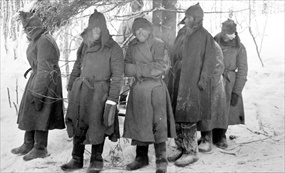 |
Left: As Soviet troops and vehicles filed along forest roads, Finnish ski troops were able to stealthily move into position and destroy vehicles at the front and rear of the column. With the road blocked, Finnish defenders could then encircle and destroy the trapped Red Army. In this photo dead Soviet soldiers lie in the aftermath of a devastating attack on their column during the Battle of Raate Road, which took place during the first week of January 1940. Soviets losses were put at between 7,000 and 9,000 men. The Russian State Military Archive confirms that 167,976 Soviet soldiers were killed or went missing during the 105-day Winter War. For their part, Finnish historians estimate 25,904 of their countrymen died or went missing and 43,557 were wounded in the Winter War.
![]()
Right: Wounded and freezing Red Army soldiers after their capture in February 1940. The Finns held some 5,572 Soviet POWs at the conclusion of the war, while the Soviets held 800–1,000 Finns. It is believed most of the Soviets who were repatriated to their homeland were killed in camps run by the Soviet secret service, the NKVD.
The Winter War Between the Soviet Union and Finland, 1939–1940
![]()

 History buffs, there is good news! The Daily Chronicles of World War II is now available as an ebook for $4.99 on Amazon.com. Containing a year’s worth of dated entries from this website, the ebook brings the story of this tumultuous era to life in a compelling, authoritative, and succinct manner. Featuring inventive navigation aids, the ebook enables readers to instantly move forward or backward by month and date to different dated entries. Simple and elegant! Click
History buffs, there is good news! The Daily Chronicles of World War II is now available as an ebook for $4.99 on Amazon.com. Containing a year’s worth of dated entries from this website, the ebook brings the story of this tumultuous era to life in a compelling, authoritative, and succinct manner. Featuring inventive navigation aids, the ebook enables readers to instantly move forward or backward by month and date to different dated entries. Simple and elegant! Click 











